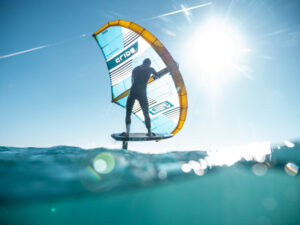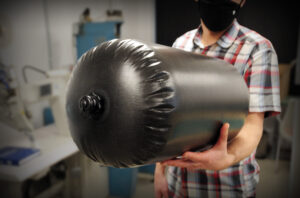
ALUULA Composites is going from windsports to way beyond
Canadian Plastics
Canadian Plastics Materials Research & DevelopmentFrom kitesurfing to landing on Mars is a giant leap, but it’s one this British Columbia-based firm might be poised to take.

Photo Credit: ALUULA Composites
When you think of kitesurfing, a sport that involves using wind power with a large power kite to pull a rider across the water, you probably think of someplace like Florida or Hawaii. But British Columbia, the city of Vancouver included, has countless beaches which are kiteable during the summer, which may help explain the origins of Victoria, B.C.-based advanced materials technology firm ALUULA Composites.
And how ALUULA might come to play a role in a NASA mission to the Moon or even Mars someday could be an even bigger story.
OUTDOOR ORIGINS
Founded in 2019 by a group of chemists and engineers with a passion for outdoor sports, ALUULA uses a proprietary fusion technology that bonds films at a molecular level to an ultra-high molecular weight polyethylene – or UHMWPE – core, resulting in a new generation of performance composite fabrics that deliver unique and superior performance results. An offshoot of research and development in ultra-light fabrics at Ocean Rodeo Sports Inc. – a kiteboarding and wingsurf company also headquartered in Victoria – ALUULA’s initial objective was to improve the performance of kiteboarding kites through materials science. “Kiteboarding was established more than 20 years ago, and has seen some significant advancements in rider safety, product handling, and control, but the standard legacy materials and seaming techniques, originally adopted from the sail industry, had stalled the technical advancement of the sport,” said Greg Falck, ALUULA’s Senior Materials Scientist. “We wanted to develop ultralight materials that could withstand the rigors of a kite’s pressurized airframe. This includes high strength; seam holding; and resistance to UV, salt water, tear, and punctures. We were intrigued by the properties of UHMWPE fibre, and wanted to find a way to create a fabric that could utilize it.”
Chemistry was the first order of business, since UHMWPE fibre is very difficult to glue and the properties of adhesives are affected by UV and water exposure. “We developed a molecular fusion process to bond the fibre to various technical films,” Falck said. “After a series of various trial runs and combinations, the material achieved our goal in the kitesurfing and wingsurfing market.” Early testing also revealed the performance increase wasn’t restricted to the lighter weight, Falck continued, since the higher modulus of UHMWPE fibre made for more responsive, higher performance airframes that were less prone to deformation under load.
The resulting product line is a new family of composite materials that are easily fabricated into a multitude of products across a wide range of markets. The company’s proprietary trademarked fabrics include ALUULA Gold GC-82, an 82-gsm fabric used within wind sports for lightweight, rigid airframe structures; ultra-durable, lightweight ALUULA Durlyte, for ultra-durability and high-performance inflatable structures; ALUULA Aeris, for ultralight canopy, spinnaker, and ultralight pack applications; and ALUULA Graflyte, which has been designed specifically for the ultralight pack market. Since Durlyte, Aeris and Graflyte are all 100 per cent polyethylene, research with the University of British Columbia is ongoing to create compression molded hard composite panels from offcuts and end-of-life products.

A sample heat welded cylinder made of ALUULA Durlyte composite weighing only 140 grams per square meter. Photo Credit: ALUULA Composites
The UHMWPE comes to ALUULA courtesy of its partners in Asia, which weave the fibre into different configurations, depending on customer needs. “We can adjust the balance of the fabric for strength in various directions to optimize the strength-to-weight ratio for an application” Falck said. “We source our UHMWPE from both China and the U.S., while our technical films come from all over the world – including Canada, the U.S., Europe, South America, and China. Our specialty is coming up with novel material layups to suit our customer’s demanding applications, and our patented fusion process occurs exclusively at our Vancouver Island facility.” ALUULA runs a streamlined manufacturing operation based on the principals of Lean manufacturing, Falck continued, with production process utilizing self-contained “pods” to produce the end-product as opposed to a larger in-line manufacturing system. “The pods give us the scalability to handle large fabric orders while maintaining the flexibility to do iterate small batches of new materials for customers,” Falck said. “The sailing industry is already very technically adept, and we’re completing a software program that generates predictive models of the attributes of any combination of our materials and weaving technologies to meet the various demands of sail design teams.”
WINDSPORTS AND MORE
Within windsports, ALUULA’s materials are said to be half the weight of traditional materials, and also stiffer and stronger than existing composite options. Specifically, kite and wing airframes are built by sewing patterned pieces of fabric together to create 3D shapes, and an internal bladder is then installed and inflated at high pressure to create the kite’s structure and rigidity. According to Falck, kiteboarders using a lightweight ALUULA composite kite can fly in much lighter wind, while the increased stiffness delivers much better performance in stronger winds.
ALUULA’s first customer was its parent company Ocean Rodeo, but its fabric has since been commercialized by other kitesurfing suppliers including Duotone, said to be the sport’s biggest brand. “Kiteboarding was already a relatively high-end sport, and we only make high-end products, so we’re well-positioned to claim a very good market share – perhaps as much as 30 per cent of the kitesurfing sector within the next few years,” Falck said.
And beyond windsports, ALUULA is now working with industry partners to develop next-level materials for applications in aerospace, outdoor gear, sailing, and defense markets. “We quickly realized that this was a soft materials technology that wasn’t going to be limited to kitesurfing – there are an infinite number of possibilities, because we can incorporate different films with our UHMWPE formulations and also have different weights, distributions, and directions of weaving,” Falck said. “With backpacks, for example, we want to replace nylon and polyester materials currently being used; and we’ve had inquiries from the commercial aerospace sector about lightweighting fabrics without sacrificing strength and durability.”
Most recently, ALUULA’s composite materials have been selected by Chilliwack, B.C.-based technology developer Thin Red Line Aerospace to support its development of cutting-edge, critical application hardware for future NASA lunar and Mars missions. “Thin Red Line is responding to a NASA requirement, and our material uniquely met their need,” Falck said. “The project is still in the early stages: Thin Red Line has ordered batches of our materials for product development, and we’ll see where it goes, but it’s a vote of confidence in our fabrics and a really exciting possibility.”
These efforts are driving further innovation and intellectual property in the material bonding sciences, as ALUULA continues to develop promising additional cross-linking technology with its chemistry partners. ALUULA is also exploring additional manufacturing techniques, Falck said, including heat welding, steam taping, and molding in the development of air- and water-tight structures.
With ALUULA becoming established as a high-performance brand and its composite materials on the cusp of wider commercialization, the company is right where it wants to be. “We’re targeting high-tech applications that require a soft structural fabric, not everyday consumer items,” Falck said. “We’re already involved in all of the high-performance niches that we want to be, so the goal going forward is to expand our business in these areas. We offer a process, not a product, and this allows for a wide range of iterations to meet a broad range of applications.”
And with the potential of landing one or more of its materials on the Moon or even Mars, not even the sky is the limit.
